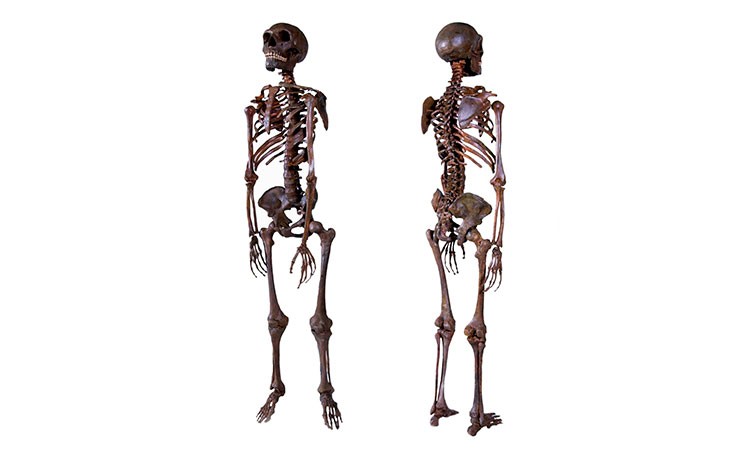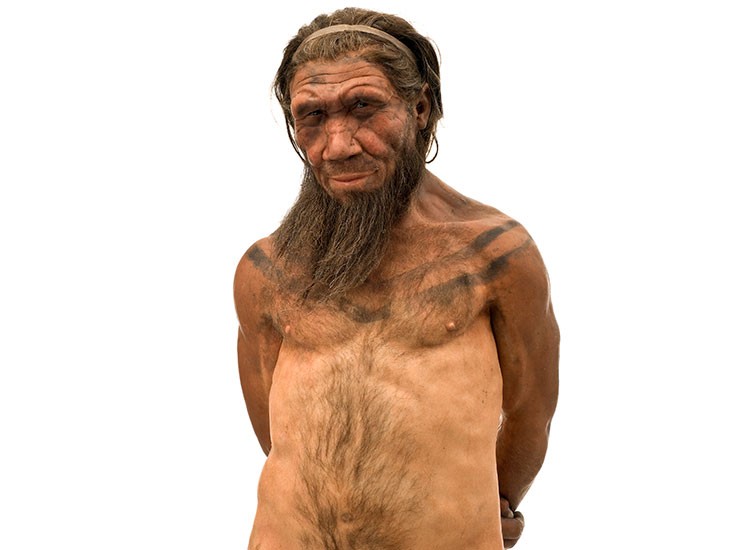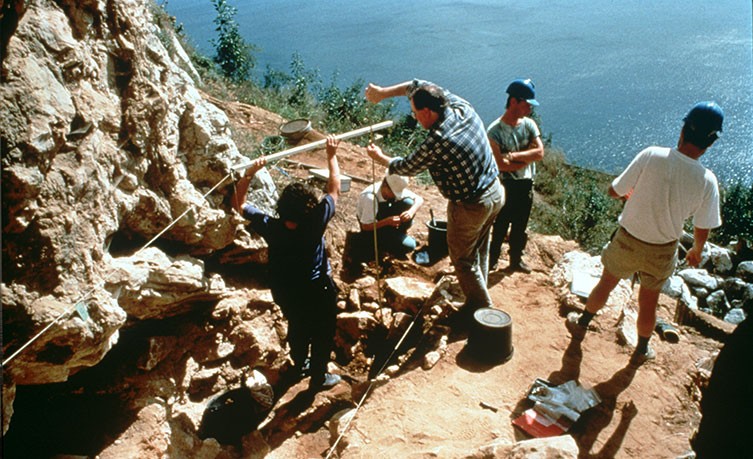Neanderthals, a distinct species of Homo neanderthalensis, coexisted with early modern humans for a significant period. This article from COMPARE.EDU.VN delves into the physical characteristics of Neanderthals, comparing their size, build, and other features with those of modern humans. Understand their evolutionary history, distribution, and the reasons behind their eventual extinction and learn how they differ in stature, muscle mass, brain size, and other factors.
1. Understanding Neanderthals: Our Closest Relatives
Neanderthals (Homo neanderthalensis) were a separate species of humans who lived in Europe and Asia from about 400,000 to 40,000 years ago. They were our closest extinct human relatives, sharing a common ancestor with modern humans (Homo sapiens). Understanding their physical attributes requires a detailed examination of fossil evidence and comparative analysis.
1.1. Defining Characteristics of Neanderthals
Neanderthals possessed several distinctive characteristics:
- Cranial Features: They had a long, low skull with a prominent brow ridge.
- Facial Structure: Their faces featured a protruding central part and a large, wide nose.
- Body Build: Neanderthals were strong and muscular, with wide hips and shoulders.
- Height: They typically stood between 1.50 to 1.75 meters (about 4’11” to 5’9″).
- Weight: Their weight ranged from 64 to 82 kilograms (approximately 141 to 181 pounds).
1.2. Evolutionary Context and Timeline
The Neanderthal lineage evolved in Europe and Asia, diverging from the modern human lineage in Africa around 500,000 to 650,000 years ago. Key milestones in their history include:
- Early Presence: Neanderthal-like fossils appeared as early as 430,000 years ago.
- Peak Period: The best-known Neanderthals lived between 130,000 and 40,000 years ago.
- Geographic Range: Their habitat spanned from Portugal and Wales in the west to the Altai Mountains of Siberia in the east.
2. How Big Were Neanderthals Compared to Humans? The Size Factor
A crucial aspect of comparing Neanderthals and modern humans is their size. While both species were human, differences in height, weight, and body proportions reflect adaptations to different environments and lifestyles.
2.1. Height and Stature Comparison
Neanderthals were generally shorter than modern humans. The average height of Neanderthals was between 1.50 to 1.75 meters (4’11” to 5’9″), while modern humans typically range from 1.60 to 1.80 meters (5’3″ to 5’11”). This difference in stature may seem small, but it contributed to overall physical distinctions.
2.2. Weight and Muscle Mass
Neanderthals were more heavily built than modern humans. Their weight ranged from 64 to 82 kilograms (141 to 181 pounds), indicating greater muscle mass and bone density. This robust build provided them with the strength and resilience needed to survive in harsh climates.
2.3. Body Proportions and Adaptation
Neanderthals had stockier physiques with shorter lower legs and forearms. These proportions minimized skin surface area, helping them conserve heat in colder environments. In contrast, modern humans have longer limbs, facilitating efficient movement in warmer climates.
3. Detailed Physical Comparison: Neanderthals vs. Modern Humans
To fully understand the physical differences, a detailed comparison is essential. This includes examining cranial features, facial structures, limb proportions, and overall body composition.
3.1. Cranial and Facial Features
- Skull Shape: Neanderthals had a long, low skull, while modern humans have a more globular skull.
- Brow Ridge: Neanderthals possessed a prominent brow ridge above their eyes, a feature less pronounced in modern humans.
- Facial Protrusion: The central part of the Neanderthal face protruded forward, with a large, wide nose adapted for colder environments.
- Chin: Neanderthals lacked a prominent chin, unlike modern humans.
3.2. Skeletal Structure and Muscle Development
- Bone Density: Neanderthal bones were denser and more robust than those of modern humans, indicating a greater physical strength.
- Muscle Attachments: The skeletal structure of Neanderthals shows larger muscle attachments, suggesting a more muscular build.
- Limb Proportions: Shorter lower legs and forearms in Neanderthals compared to the longer limbs of modern humans.
3.3. Brain Size and Cognitive Abilities
- Brain Volume: Neanderthals had a brain size ranging from 1,200cm3 to 1,750cm3, which is larger than the modern human average. However, this difference may be proportional to their larger body size.
- Cognitive Functions: Despite having larger brains, Neanderthals displayed sophisticated tool-making skills, hunting strategies, and social behaviors, indicating a high level of cognitive function.
4. Environmental Adaptation and Physical Traits
The physical characteristics of Neanderthals were largely influenced by their environment. Living in colder climates required specific adaptations for survival.
4.1. Cold Climate Adaptations
- Stocky Build: Minimizing skin surface area to conserve heat.
- Large Nose: Warming and moistening cold, dry air before it reaches the lungs.
- High Calorie Diet: Consuming a diet rich in meat and fats to generate heat and energy.
4.2. Hunting and Survival Strategies
- Muscular Build: Providing the strength needed for close-range hunting of large animals.
- Advanced Tool Use: Developing sophisticated tools and hunting techniques for survival.
- Social Cooperation: Working together in groups to hunt and protect themselves.
5. Neanderthal Intelligence and Behavior
Challenging the stereotype of primitive cavemen, Neanderthals exhibited considerable intelligence and complex behaviors.
5.1. Tool Making and Technology
- Levallois Technique: Developing an innovative stone technology for tool production.
- Handaxes and Spears: Crafting sophisticated tools for hunting and daily tasks.
- Fire Use: Mastering the ability to make and control fire for warmth, cooking, and protection.
5.2. Social Structure and Culture
- Caring for the Sick: Archaeological evidence suggests that Neanderthals cared for their sick and injured.
- Burial Practices: Neanderthals buried their dead, indicating a sense of social and emotional connection.
- Symbolic Behavior: Creating jewelry and possibly using pigments for body decoration.
5.3. Comparing Cognitive Abilities with Homo Sapiens
While Neanderthals were intelligent, there are some differences in cognitive abilities compared to Homo sapiens:
- Abstract Thinking: Modern humans seem to have had a greater capacity for abstract and symbolic thought.
- Innovation: Modern humans developed more varied and complex technologies and cultural practices.
- Adaptability: Homo sapiens showed greater adaptability to different environments, leading to their global spread.
6. Genetic Insights and Interbreeding
Genetic studies have revealed crucial insights into Neanderthal DNA and their interactions with modern humans.
6.1. Neanderthal Genome Sequencing
- Ancient DNA Analysis: Reconstructing Neanderthal genomes from ancient DNA obtained from their fossils.
- Genetic Diversity: Discovering that Neanderthals had relatively low genetic diversity in their last 20,000 years.
- Inbreeding Signs: Finding signs of long-term inbreeding in some Neanderthal populations.
6.2. Interbreeding with Modern Humans
- DNA Inheritance: Modern humans of non-African descent have inherited around 2% Neanderthal DNA.
- Genetic Exchange: Intimate encounters and interbreeding between Neanderthals and modern humans.
- Impact on Modern Humans: Neanderthal genes have influenced certain traits in modern human populations.
7. The Extinction of Neanderthals: Causes and Theories
The extinction of Neanderthals remains a topic of scientific debate. Several theories attempt to explain their disappearance.
7.1. Competition with Modern Humans
- Resource Competition: Early modern humans may have competed with Neanderthals for resources.
- Technological Advantage: Modern humans may have had superior technologies and hunting strategies.
- Population Dynamics: The arrival of modern humans in Europe may have led to the gradual replacement of Neanderthals.
7.2. Climate Change and Environmental Factors
- Climatic Fluctuations: Regular and extreme climatic fluctuations may have fragmented Neanderthal groups.
- Environmental Stress: Rapid and dramatic climate change may have affected the plants and animals Neanderthals relied on.
- Adaptability Limits: Neanderthals may have been less adaptable to changing environmental conditions compared to modern humans.
7.3. Other Contributing Factors
- Low Genetic Diversity: Reduced ability to adapt to new diseases or environmental changes.
- Small Population Size: Making them more vulnerable to extinction events.
- Stochastic Events: Random events such as disease outbreaks or natural disasters.
8. Archaeological Discoveries and Fossil Evidence
Key archaeological discoveries have significantly contributed to our understanding of Neanderthals.
8.1. Notable Fossil Finds
- Neanderthal 1: The partial skeleton found in the Neander Valley in Germany in 1856, the first recognized Neanderthal fossil.
- Sima de los Huesos Remains: Over 6,500 human fossils representing about 28 individuals found in Atapuerca, Spain.
- Swanscombe Skull: A 400,000-year-old partial skull found in the Thames valley in England.
- Steinheim Cranium: A cranium found in Germany estimated to be 250,000-350,000 years old.
8.2. Significance of the Discoveries
- Evolutionary Insights: Providing valuable information about the physical characteristics and evolutionary history of Neanderthals.
- Behavioral Clues: Revealing insights into their tool-making skills, hunting strategies, and social behaviors.
- Environmental Context: Helping to reconstruct the environments in which Neanderthals lived and adapted.
9. Revisiting Neanderthal Stereotypes
Modern scientific research challenges long-held stereotypes about Neanderthals as primitive and unintelligent.
9.1. Intelligence and Adaptability
- Complex Tool Use: Demonstrating advanced technological skills.
- Resourcefulness: Surviving in challenging environments through innovation and cooperation.
- Cognitive Abilities: Exhibiting sophisticated cognitive functions comparable to early modern humans.
9.2. Social and Cultural Complexity
- Caring for Others: Showing compassion and care for the sick and injured.
- Symbolic Expression: Creating jewelry and possibly engaging in artistic expression.
- Burial Practices: Displaying respect for the dead through burial rituals.
10. The Ongoing Research and Future Directions
Research on Neanderthals continues to evolve, with new discoveries and technologies providing deeper insights into their lives.
10.1. Advanced Technologies and Methodologies
- Ancient DNA Sequencing: Unlocking new information about Neanderthal genetics and evolution.
- 3D Modeling and Reconstruction: Creating detailed models of Neanderthal anatomy and behavior.
- Isotope Analysis: Studying Neanderthal diets and environmental adaptations.
10.2. Unanswered Questions and Future Research
- Extinction Causes: Further investigating the factors that led to the extinction of Neanderthals.
- Cognitive Differences: Exploring the subtle differences in cognitive abilities between Neanderthals and modern humans.
- Cultural Practices: Uncovering more evidence of Neanderthal culture and symbolic behavior.
11. Comparative Table: Neanderthals vs. Modern Humans
| Feature | Neanderthals | Modern Humans |
|---|---|---|
| Height | 1.50-1.75 meters (4’11” – 5’9″) | 1.60-1.80 meters (5’3″ – 5’11”) |
| Weight | 64-82 kg (141-181 lbs) | 55-75 kg (121-165 lbs) |
| Skull Shape | Long and low | More globular |
| Brow Ridge | Prominent | Less prominent |
| Facial Structure | Protruding central part, large nose | Flatter face, smaller nose |
| Chin | Absent or weak | Prominent |
| Body Build | Stocky, muscular | More slender |
| Limb Proportions | Shorter lower legs and forearms | Longer limbs |
| Brain Size | 1,200-1,750 cm3 | 1,100-1,400 cm3 |
| Environmental Adaptation | Adapted to cold climates | More adaptable to varied climates |




This table provides a concise overview of the key physical differences between Neanderthals and modern humans, highlighting how Neanderthals were adapted to their specific environmental conditions.
12. The Legacy of Neanderthals
Even though Neanderthals went extinct, their legacy lives on in our understanding of human evolution and our own genetic makeup.
12.1. Contributions to Our Understanding of Human Evolution
- Divergence and Evolution: Studying Neanderthals helps us understand the complexities of human evolution and the divergence of different human species.
- Adaptation and Survival: Learning about their adaptations to harsh environments provides insights into the challenges faced by early humans.
- Interbreeding and Gene Flow: The discovery of Neanderthal DNA in modern humans highlights the interconnectedness of human populations.
12.2. The Enduring Fascination with Neanderthals
- Popular Culture: Neanderthals continue to fascinate the public and are often depicted in books, movies, and documentaries.
- Scientific Research: Ongoing research on Neanderthals promises to reveal even more about their lives and their place in human history.
- Human Identity: Understanding Neanderthals helps us to better understand ourselves and what it means to be human.
13. Frequently Asked Questions (FAQ) about Neanderthals
-
How tall were Neanderthals compared to modern humans?
- Neanderthals were generally shorter, averaging between 1.50 to 1.75 meters (4’11” to 5’9″), while modern humans average between 1.60 to 1.80 meters (5’3″ to 5’11”).
-
Were Neanderthals stronger than modern humans?
- Yes, Neanderthals were generally stronger due to their more muscular build and denser bones.
-
Did Neanderthals have bigger brains than modern humans?
- Neanderthals had larger brains on average, ranging from 1,200cm3 to 1,750cm3, but this may be proportional to their larger body size.
-
What did Neanderthals eat?
- Their diet included meat, plants, fungi, and shellfish when available, with a focus on large mammals for sustenance.
-
Why did Neanderthals go extinct?
- The extinction is likely due to a combination of factors, including competition with modern humans, climate change, and low genetic diversity.
-
Did Neanderthals and modern humans interbreed?
- Yes, genetic evidence shows that modern humans of non-African descent have around 2% Neanderthal DNA.
-
What kind of tools did Neanderthals use?
- Neanderthals used sophisticated tools made using the Levallois technique, including handaxes, spears, and other stone implements.
-
Where did Neanderthals live?
- Neanderthals lived in Europe and Asia, ranging from Portugal and Wales in the west to the Altai Mountains of Siberia in the east.
-
Were Neanderthals intelligent?
- Yes, Neanderthals were intelligent and capable, evidenced by their tool-making skills, hunting strategies, and social behaviors.
-
What is the significance of studying Neanderthals?
- Studying Neanderthals provides insights into human evolution, adaptation, and the factors that shape our species.
14. Discover More at COMPARE.EDU.VN
Understanding the physical attributes of Neanderthals provides valuable insights into human evolution and the adaptations that allowed them to thrive in challenging environments. By comparing their size, build, and other characteristics with those of modern humans, we gain a deeper appreciation for the diversity and complexity of our human ancestors.
Ready to make informed decisions? Visit COMPARE.EDU.VN today for comprehensive comparisons and expert insights. Whether you’re evaluating educational opportunities, consumer products, or scientific concepts, COMPARE.EDU.VN empowers you with the knowledge you need.
Contact us:
Address: 333 Comparison Plaza, Choice City, CA 90210, United States
WhatsApp: +1 (626) 555-9090
Website: COMPARE.EDU.VN
Alt: Visual comparison of Neanderthal and Homo sapiens showcasing physical differences in skull shape, brow ridge, and body structure
At COMPARE.EDU.VN, we understand the importance of making well-informed decisions. That’s why we offer detailed and objective comparisons across a wide range of topics. From educational programs to consumer products, our platform is designed to help you evaluate your options and choose the best fit for your needs. Don’t make decisions in the dark – let compare.edu.vn light the way.